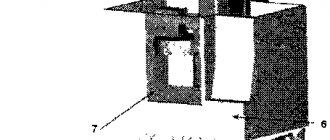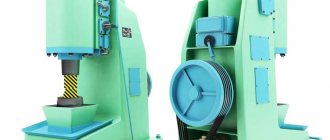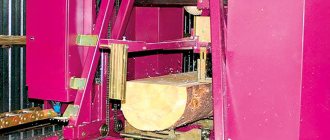began supplying high-quality cutting equipment to the Russian market in 1998. Since tape-cutting technology was completely new for most Russian companies at that time, it took quite a lot of time to promote it. However, starting from 2001-2002, supplies of equipment grew at a rapid pace. To date, we have supplied and successfully implemented more than 2,800 pieces of equipment to Russian enterprises.
It is pleasant to note that high-quality equipment and active customer service support from Rosmark-Stal CJSC specialists made it possible to keep about 80-85% of the machines in working condition, despite the working life declared by the manufacturers for about 10 years. At the same time, the longer the machine operates, the more time and money it requires to maintain it.
Taking into account all these factors, our company decided to open a new direction for the restoration and modernization of band cutting machines manufactured by FMB, Italy, supplied by our company.
The secondary equipment market is still relevant both in Russia and in Europe; it can be divided into two categories:
- Equipment "as is"
- Equipment after restoration and modernization
What challenges are we coping with?
Our organization provides a wide range of services. We employ qualified craftsmen with the necessary knowledge. They successfully solve problems of varying degrees of complexity. It could be:
- emergency repair of machines - it is required when the devices are already out of order. First, specialists inspect the equipment and identify problems. Then actions are taken to eliminate them. During repairs, high-quality components are used. The work is carried out smoothly and in a short time. Therefore, the production process will soon resume;
- scheduled repairs of electrical equipment - its main purpose is to check the performance of turning, milling, and metal-cutting machines. If necessary, individual parts and assemblies are replaced. This prevents serious breakdowns and eliminates the risk of force majeure situations in production. With timely maintenance, their service life increases. Therefore, it is necessary to carry out regular maintenance of devices;
- equipment overhaul is a set of works performed to restore the functionality of industrial machines. It includes disassembling the machine into individual components, cleaning parts from contamination, and replacing worn elements. After completion of all processes, the quality of the equipment is checked. If necessary, the systems are adjusted in accordance with the specified parameters.
Equipment after restoration and modernization
This type of equipment is of particular interest.
This category includes equipment that has undergone restoration and modernization work, such as: replacing hydraulic, mechanical and electrical parts with new ones without changing the design of the machine, which allows the equipment to return to its original technical characteristics. Flaws:
- shorter service life compared to new equipment;
- higher purchase cost compared to equipment that has not undergone restoration and modernization.
Advantages:
- lower purchase cost compared to new equipment;
- low payback period compared to new equipment;
- carrying out commissioning and installation supervision works;
- training;
- technical support;
- installation of additional options at the client’s request;
- warranty on supplied equipment.
What are our advantages?
occupies a leading position in the market. We have been working in Moscow since 2006. This is an important indicator that demonstrates professionalism and experience. Clients appreciate it and recommend our organization to business partners.
By contacting us, you will not regret it! We have important advantages:
- A wide range of services - we carry out repairs of grinding, boring, screw-cutting lathes, rotary lathes, wheel lathes, drilling machines, as well as balancing equipment.
- Reasonable price - the cost of our work is reasonable.
- Providing a guarantee - repairs of CNC machines are carried out in accordance with standards.
- Professionalism is the successful solution of any technical problems. For example, repair of spindles or major overhauls.
- High-quality maintenance of industrial equipment is the key to the operability of devices and the absence of force majeure situations.
We will carry out diagnostic measures and eliminate faults in a short time. Therefore, the production process will not stop for long.
Screw-cutting lathe 16k20 after major repairs
Work performed:
- External inspection of equipment.
- Disassembly of equipment unit by unit.
- Disassembling components and drawing up a defect list.
- Grinding or scraping of the guides of the basic parts of the machine: bed, stand, table, headstocks, etc.
- Repair or replacement of lead screws, ball screws and nuts of moving units.
- Repair or replacement of the hydraulic system, lubrication, “coolant” (cutting zone cooling system).
- Development of a new basic and executive electrical circuit.
- Technical design of new electrical circuits, installation of electrical cabinet.
- Installation of new reference systems and reference sensors for moving moving units.
- Overhaul of machine components with replacement of gears, shafts, bearings, rings, keys, etc. in accordance with the PPR for major repairs.
- General assembly of the machine.
- Integration of a new CNC system, DRO on the control panel or electronic cabinet (at the request of the customer).
- Docking of the electrical cabinet, hydraulics, CNC, drives with the machine.
- Running in the machine at idle speed. Testing of all components and assemblies.
- Machine painting.
- Handover of the machine according to accuracy standards in accordance with the specifications of the machine, GOST and machine accuracy standards
- Shipment of the machine to the customer according to the contract
Equipment "as is"
Typically, such equipment is in operation, or the equipment is not operational or is not in use, because
restoration is not possible or practical. Most often, such equipment is presented to the buyer only cleaned of production dirt. Advantages:
- low purchase cost.
Flaws:
- the difficulty of objectively assessing the performance of all equipment systems;
- failure to detect faults or hidden wear;
- low productivity and processing accuracy;
- no warranty.
With this kind of transaction, the buyer runs the risk of receiving inoperative or, even worse, non-repairable equipment, i.e., a “pig in a poke.”
Lathe device
A classic lathe made in the USSR consists of the parts shown in the drawing:
Lathe device - front view
This figure does not show everything, only some parts, but this is enough for a basic understanding. The parts that are related to electrical are highlighted.
- 8 – handle for clutch and switching direction of spindle rotation. The important thing is that this handle acts on the zero stroke limit switch - while it is pressed, the machine will not turn on.
- 12 – Start and Stop buttons for controlling the main engine.
- 21 – non-latching button to turn on the high-speed motor (accelerated movement of the carriage).
- 24 – lighting lamp.
- 27 – direct connection ammeter, for monitoring the main motor current.
- 28 – toggle switch for turning on the engine of the coolant pump (coolant).
- 29 – power on indicator.
- 30 – power handle.
How are major components overhauled?
Overhaul of main components is carried out with the aim of restoring serviceability, complete or close to full restoration of the resource, with replacement or restoration.
Restoration of guides
Guides are one of the least worn parts of a lathe. Depending on the degree of wear, there are several methods of overhaul.
Scraping
If the error is less than 0.15 mm per 1000 mm of length, restoration is performed by scraping. The frame is installed on a repair stand and secured strictly in a horizontal plane. Scraping is carried out in three stages. The roughing pass is performed with a scraper with a working width of 20–30 mm.
Semi-finish scraping is performed with a scraper of 11–18 mm, finishing (finishing) scraping is performed with a scraper with a working width of 5–10 mm. Since the machine guides are long, scraping occurs along the beacons. This method makes it possible to obtain high processing accuracy (up to 0.002 mm per 1000 mm) and is used for non-hardened guides.
Grinding
Grinding is used for hardened guides, and also, if necessary, to speed up the repair process. Processing is carried out with a cup grinding wheel, making it possible to carry out repairs without disassembling the machine. Sanding is a much more productive process than scraping. This method allows you to obtain high accuracy and low surface roughness of the guides.
Planing
In case of serious wear (more than 0.15 mm per 1000 mm), the guides can be corrected by planing. Processing by planing according to the duration of the operation is the fastest method. However, the duration increases during transportation. Planing is carried out in two stages: rough planing aligns the guides, and finishing (minimum 2 passes) removes an additional layer of metal.
bed
As for the bed, it is necessary to eliminate inaccuracies that arise when the guides wear out. The specific restoration method chosen in a particular situation depends on one degree or another of wear. If there is an inaccuracy of 0.15 mm per 1 meter, scraping is used; if it is large, restoration is carried out by planing or grinding.
Tailstock
The tailstock is used to secure the workpiece and tool. This is one of the most used components of the machine. During repairs, the connection between the headstock and the frame should be restored, the play should be eliminated, and the accuracy of the hole and the location of the centers should be checked.
In case of malfunction, replace or repair the quill and feed screw. The hole for the quill is repaired by lapping (low-worn holes), boring with adjustment and acrylic plastic (the most effective and economical method).
Repairing the caliper carriage
When overhauling the carriage of a lathe, it is necessary to restore its lower guides that mate with the guides of the bed. Also, when restoring this mechanism, it is necessary to eliminate the play between the guides. The caliper guides are repaired by grinding and scraping. After a major overhaul, the carriage must be correctly aligned.
Lead screw and lead shaft
Often, during repairs it is necessary to restore the alignment of the lead screw, shaft, apron and feed box. To do this, the feed box is fixed on the frame, we install the carriage and attach the clamping bar. We install the frames into the holes of the feed box, and connect the apron to the carriage. We move the carriage towards the feed box until the frames touch. We measure the resulting clearance with a probe.
Repair by grinding
It is not always possible to use planing or longitudinal milling machines for repairs due to the long length of the lathe bed. In this case, the bed guides are restored using a portable device with a grinding head, which is installed directly on the equipment bed.
Repairs can be made on site, without removing the machine from the foundation. This method ensures high repair accuracy, low surface roughness, and is also indispensable when processing hardened surfaces. This method is many times more productive than scraping, but experts still prefer finishing planing.
[Show slideshow]
Scheduled lubrication
Maintenance of the machine involves the use of different types of mineral oils. Solid oil is traditionally used for bearings. The thickness of the oil composition depends on the speed and degree of load; the lower they are, the lower the density of the lubricants. When under load, turning equipment heats up to a certain temperature; taking this indicator into account, manufacturers set the recommended brand of oil.
It is better to determine what type of grease is suitable for lubricating a particular machine unit; this information is usually indicated on the pages of the technical passport.
There are differences not only in oils, but also in the methods of lubrication of individual parts; the following options are applicable for turning equipment:
- Circulating. The design has a special injection pump; it transports oil compounds under pressure through tubes that lead to certain components.
- Carter. Used to coat the gear box and apron worm gear system with oil. The feed box is also lubricated using the crankcase method. To implement the method, a special container is provided, filled to the required level, and gears, which carry out the spraying. To monitor the oil level, the design has control eyes and a special indicator.
- Wick. The method is as simple and old as possible, but is highly reliable. In a lathe system it is used as an addition to crankcase lubrication if there is a risk that the oil will not reach its target. A wick is pushed into the tube; the distance from it to the surface to be lubricated should be within 6-8 mm.
- Manual. Using the manual option, bearings, carriages and other components whose operation is accompanied by friction are lubricated. Oilers need to be filled; in the case of grease oil, it is convenient to use a syringe. Manual lubrication is carried out every day while the lathe is in operation.
The machine operator must constantly add oil if necessary, and also, approximately once a month, completely replace it. The indicated frequency is an approximate average, but everything depends in a particular case on the equipment and the intensity of work on it. Maintenance also includes washing and cleaning not only the filter, but also the gears and wicks.
The use of all 4 lubrication methods ensures complete maintenance, because all components that require it are lubricated with oil. This allows you to significantly extend the service life of machine parts.








